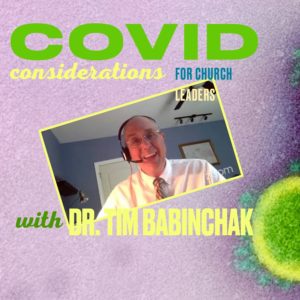May 12, 2021 in Public Health
Infectious Disease Expert Shares COVID Update

COVID Considerations for Church Leaders
COVID is not going away, yet we now have effective vaccines and effectual therapies to reduce the incidences of infections and deaths, infectious disease specialist Dr. Tim Babinchak told SEPA leaders in a Zoom conference May 11.
Dr. Babinchak, a member of St. John’s Lutheran Church, Phoenixville, and retired head of infectious diseases at Thomas Jefferson University Hospital, said that there are no zero-risk guarantees and church leaders will have to decide what risks they and their attendees are willing to take in returning to in-person worship.
Update May 15, 2021: Contacted after the CDC announced relaxed guidance for masks, Dr. Babinchak said: “My thoughts and recommendations are not changed by the CDC announcement.” He also stated agreement with the guidance released by ecumenical leaders May 13:
“For the vaccinated, the risk of hospitalization and death are greatly decreased. However, a significant and unknown number of us remain unvaccinated and thus vulnerable. The admonition that we all behave as unvaccinated in group settings where the vaccination status of those around is unknown is prudent. The masks, distancing and hand washing all reduce the risk for all. In the same lines, singing should still be masked until such time as we can be assured of the vaccinated numbers at services. As I stated, outdoors is preferable and with distancing and vaccination would not require masks for singing.”
Rather than trying to eliminate every possible risk, Dr. Babinchak suggested that we are in a new normal where care for vulnerable people and making informed, reasonable choices should be emphasized.
Dr. Babinchak proposed a four-step process for making decisions based on the makeup of a congregation:
“WHO” |
Are the people who attend vaccinated or unvaccinated? Do they have underlying conditions that might hamper the effectiveness of vaccines or lead to more serious cases? |
“WHERE” |
Outside is always better than indoors. Sufficient ventilation with outside air to dilute potential virus concentrations is always better than indoors in a poorly or non-ventilated space. |
“WHEN” |
The longer the event, the higher the risk. An hour-long worship service carries different risks than an hours-long meeting or a full-day childcare setting. |
“HOW” |
In order to minimize the risk to the most vulnerable, continue basic steps of hand-washing, masking, and distancing and consider continuing online avenues of participation for those for whom it may not be wise to attend in-person. |
Here are some general takeaways from Dr. Babinchak’s presentation:
Outdoors gatherings are always safer than indoors. (Very few cases of outdoor transmission have been documented.) The more air exchange you have indoors, the better.
People should not attend church if they are sick (regardless of whether they think they have COVID).
Emphasize hand-washing. Open restrooms or provide other ways for people to wash hands at church.
Wearing masks and maintaining distance will always lower risk. Masks protect others, not the wearer. You will not always know if you have vulnerable or ill people in your church.
If wearing your mask is comfortable, it’s probably not on correctly. Proper fit is important.
Dr. Babinchak suggested that singing softly and soft liturgical responses with masks is possible indoors and outdoors. Distancing reduces risk. Remember, if someone is unvaccinated or ill, singing is a high-risk activity for those around them.
For vaccinated persons, there should be no issue with sharing communion as usual, Dr. Babinchak said. Provide other options for unvaccinated or vulnerable persons.
Coffee hours and social times are best done outdoors and kept short.
It is safe to return hymnals to the pews. As long as people wash hands and stay home if they are sick, there should be no problem. If services are back-to-back, materials should be cleaned in between.
There is little risk of transmission when people move in the sanctuary; for example, to read at the lectern or participate in a children’s sermon. Close grouping of people has a higher risk.
This educational presentation contains the professional opinions of the presenter for use by church leaders in decision-making, and does not constitute advice or recommendations from the synod.
Thank you to Rob Unger and Catherine Fink for contributing to this summary.

